Annual Report - 2010
When it comes to media exposure of my work, recent years have been kind of feast or famine (mostly famine actually!) This past year was somewhere in the middle - not many chances overall, but some interesting ones!
Edo-Gaku, November 2010
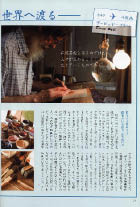 This is a relatively new magazine, very beautifully printed, which highlights products, places, and activities in and around Tokyo which are relevant to people with an interest in the history of this place - the Edo days. Well that certainly includes me, so I of course agreed without hesitation to their interview request.
This is a relatively new magazine, very beautifully printed, which highlights products, places, and activities in and around Tokyo which are relevant to people with an interest in the history of this place - the Edo days. Well that certainly includes me, so I of course agreed without hesitation to their interview request.
In his workshop surrounded by greenery, he works, thinking about the people 300 years from now. "Most of the products built in large factories today will actually end up becoming garbage in the end. My prints will not. In the same way that the prints made back in the Edo era have lasted 2~300 years - with the paper becoming soft and beautifully aged - my work will be enjoyed by generations of people yet unborn!"
Playboy, September 2010
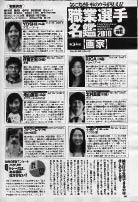 Yes, look at that, I made it into Playboy! But before western readers get all excited and ask me for extra copies of this one, I have to tell them that my part in the show was of no 'particular' interest to most readers of the magazine.
Yes, look at that, I made it into Playboy! But before western readers get all excited and ask me for extra copies of this one, I have to tell them that my part in the show was of no 'particular' interest to most readers of the magazine.
Simply the editors have a regular feature where they select a particular field and interview a group of people about their working life. Their choice this time was 'artist', which is why they called me.
There is no special content to report, but doesn't this make a nice entry on my résumé!
That was it for print items, but the undeniable highlight of last year's media attention was the program I did for NHK in September.
Japanophiles, NHK World
I talked about this program in the previous newsletter, but there is more to report about it now, six months later.
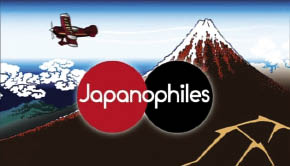 And what needs to be reported is that it has turned out to be the most successful TV presentation I have ever been involved with - introducing more than two dozen new collectors to my work.
And what needs to be reported is that it has turned out to be the most successful TV presentation I have ever been involved with - introducing more than two dozen new collectors to my work.
This is a result that quite honestly I had not foreseen. Being on TV - even very widely broadcast programs - is not a new experience for me, and I have learned that although it can be fun and interesting to do, the exposure usually doesn't help the business side of my activities at all. This time was different though, and I think there were two main reasons for that: first is that the viewers were not a 'random' audience - these were people who already had an interest in Japan and Japanese culture; that's why they were watching that channel. So of course they were 'primed' to be receptive to the content of the program.
The second reason was the content itself; the producers not only introduced my work in general terms, they got very specific - putting my Mystique set on a table right in front of the camera and asking me to talk about it with host Peter Barakan. That scene was almost an 'infomercial', something we don't see on NHK very often!
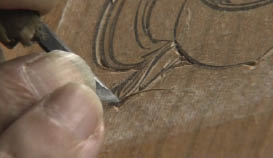 All those new collectors are reading this newsletter now, and I hope they will join me in a 'thank you!' to NHK for introducing us to each other!
All those new collectors are reading this newsletter now, and I hope they will join me in a 'thank you!' to NHK for introducing us to each other!
That's pretty much it for the media side of this yearly roundup. Long-time collectors know what comes next - it's time for the bookkeeping part of this 'Annual Report'!
Do I sound cheerful? You bet! Actually, given the tenor of the news that has filled this particular slot for the past few years, almost anything would be an improvement!
The news is simple to report: after a number of years of steadily decreasing income, and last time actually being in the red, I have managed to turn things around, as you can see from the accompanying spreadsheet. There is no mystery about this, as the Mystique series is turning out to be very popular. The prints are quite attractive, and given that they are also very inexpensive, orders have been good.
Producing the series is turning out to be 'somewhat' more work than I anticipated, but with my mortgage now being history - as I reported a couple of months ago - I am able to spend more time on each print without having to worry about whether I can get it out the door in time to make a bank payment.
So for the first time in quite a few years I now have a positive bank balance, and instead of living hand-to-mouth, am even adding to a savings account bit by bit. And I have done this over the past year, despite the fact that we are in the worst economic climate of our lifetimes.

This now brings up an interesting question - where do we go from here? The current Mystique series will come to an end sometime later this year, and my income will of course drop back to zero at that time. The obvious course of action will be to come up with an idea for a new series, and I guess I will probably do that. Some collectors will then leave, some will stay, and some new ones will join, attracted by whatever it will be.
But in recent years - as some of you who have chatted with me personally can attest - I have started to give some thought to a 'bigger picture'.
Let me put down some 'random' data points here:
- The other day, I attended the kanreki party of one of the collectors, Mrs. Jeannette Ohmae (who was introduced in this newsletter back in the summer of 2005.) It was a wonderful party, and focussed on her many achievements - musical and family. But before we left, she made a speech and told us about her plans for the future; she is setting up an organization to host concerts for up-and-coming musicians, with an emphasis on performers from developing countries. She has plans!
- I am the same age - this is my kanreki year too - and have been trying to peer into the 'distant' future for myself. The daily life I have at present is very pleasant indeed - long peaceful days spent by myself down in my riverside workroom, producing objects that people are happy to make their own. But could/should I still be doing that when I am (say) 80? 90? Would it be sensible for an elderly man to continue to live like such a hermit?
- Because of the lack of business in this field, it is getting more and more difficult every year to obtain the supplies I need for this work. As just one example, I learned last month that the only company in Japan still providing traditional nikawa glue (used by not only printmakers, but nihonga painters too) has gone out of business. At present, the product is completely unavailable and nobody can see where a solution will be found.
- The country that I have made my home - modern Japan - is in a very strange condition recently. Traditional patterns of life and employment have been fractured, and a great many young people are finding themselves without any kind of clear direction for their future employment. (Just how the recent natural disasters will exacerbate this I cannot foresee at this point.)
- As I mentioned in the previous issue of this newsletter, I have come to the end of my mortgage, and am now the free-and-clear owner of this building. I must still pay taxes and maintenance of course, but there is no longer a 'big hit' every month. Suddenly, I have financial resources 'available' ...
Perhaps that's enough. I said 'random' points, but of course that was not really true; when seen together a picture does start to develop. But before I show you that picture, there is something else that I should touch on.
Let's go back in time for a minute - to the spring of 1994. I had just come to the end of the first half of the long Hyakunin Isshu series, which was a nice accomplishment, but over and above that, I had also finally become stable as a printmaker, having enough collectors to make a living at it. A dream had come true. I wrote this in Issue #15 of this newsletter back then:
"There is an interesting quotation left by George Bernard Shaw to the effect that there are two tragedies that can befall a man in his life. The first, is to never attain your dream. The second ... is to attain your dream. The implication of course, is that once you have got what you wanted, you find you are still unhappy."
I mention this again now - more than 15 years on - because there may be readers thinking "Why is Dave talking about perhaps changing his way of working? He's very successful. Isn't that enough?"
I can reply to that with another quote from what I wrote in that same newsletter story:
"I really believe Mr. Shaw's dictum is true. But I'm not worried about it. Neither about the first part, nor the second. Because I've learned a way to escape the paradox. Simply have multiple dreams: reachable ones ... but also ones that will forever remain outside your grasp."
I think you can see where we are going with this. It's time to get some serious work done on the next 'dream'!
Most of you who have been reading this newsletter for a few years know what that is. About three years ago I started up the Mokuhankan venture. The idea was simple - to work together with other craftsmen to create a number of interesting woodblock prints. I managed to publish a few designs, but over the next few years, due to the very tight financial situation I was in, was not able to carry the concept very far.
But I didn't forget about it completely, and actually, even though there are very few prints in the Mokuhankan catalogue, it has provided a not-inconsiderable part of my income since then. The idea is clearly viable. What has been missing is investment - in both time, and money.
So let's go! Over the next couple of pages, we'll have a peek at how Mokuhankan will be taking its next few baby steps!
 It has been a very difficult spring for Japan the country, and for many people who live up north. Many friends and family members have been of course very worried about whether I was affected by the natural disasters, but fortunately, I have for the most part been untouched by any problems.
It has been a very difficult spring for Japan the country, and for many people who live up north. Many friends and family members have been of course very worried about whether I was affected by the natural disasters, but fortunately, I have for the most part been untouched by any problems.


 This is a relatively new magazine, very beautifully printed, which highlights products, places, and activities in and around Tokyo which are relevant to people with an interest in the history of this place - the Edo days. Well that certainly includes me, so I of course agreed without hesitation to their interview request.
This is a relatively new magazine, very beautifully printed, which highlights products, places, and activities in and around Tokyo which are relevant to people with an interest in the history of this place - the Edo days. Well that certainly includes me, so I of course agreed without hesitation to their interview request. Yes, look at that, I made it into Playboy! But before western readers get all excited and ask me for extra copies of this one, I have to tell them that my part in the show was of no 'particular' interest to most readers of the magazine.
Yes, look at that, I made it into Playboy! But before western readers get all excited and ask me for extra copies of this one, I have to tell them that my part in the show was of no 'particular' interest to most readers of the magazine. And what needs to be reported is that it has turned out to be the most successful TV presentation I have ever been involved with - introducing more than two dozen new collectors to my work.
And what needs to be reported is that it has turned out to be the most successful TV presentation I have ever been involved with - introducing more than two dozen new collectors to my work. All those new collectors are reading this newsletter now, and I hope they will join me in a 'thank you!' to NHK for introducing us to each other!
All those new collectors are reading this newsletter now, and I hope they will join me in a 'thank you!' to NHK for introducing us to each other! 

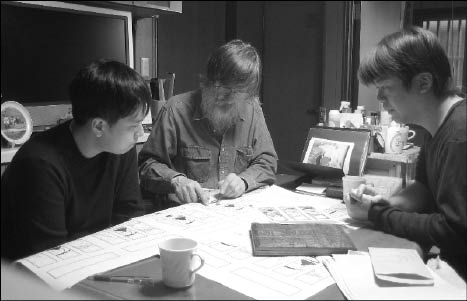
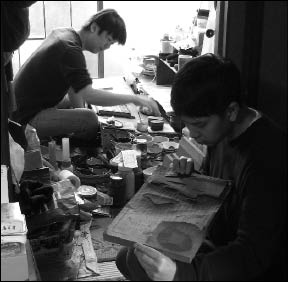 I am very happy that they have agreed to cooperate in this venture, although they have both had mixed feelings about it. They know that I am quite capable of doing their job on my own, so why would I hire other people to do it?
I am very happy that they have agreed to cooperate in this venture, although they have both had mixed feelings about it. They know that I am quite capable of doing their job on my own, so why would I hire other people to do it?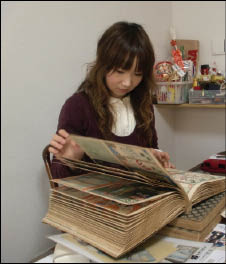 It's also time to introduce you to somebody else. Collectors of my Mystique series have already seen the work of young designer Kaori Seki (the print of Urashima Taro was her design), but the rest of you will have to wait until your set of Senshafuda arrive (you are going to order some, aren't you?) She has agreed to create the designs for the complete group of four seasonal sets for this year, with three prints in each.
It's also time to introduce you to somebody else. Collectors of my Mystique series have already seen the work of young designer Kaori Seki (the print of Urashima Taro was her design), but the rest of you will have to wait until your set of Senshafuda arrive (you are going to order some, aren't you?) She has agreed to create the designs for the complete group of four seasonal sets for this year, with three prints in each.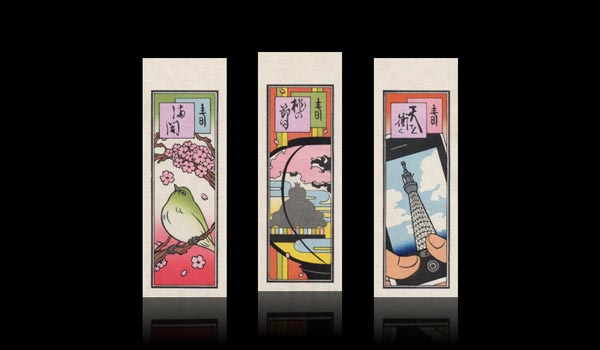
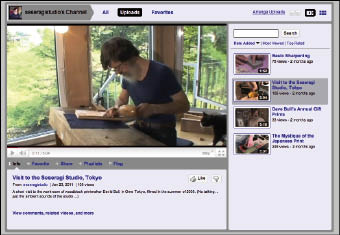 I spoke about TV in the first story in this newsletter, and there is more video news to report. I recently opened a channel on the popular YouTube video website, and have uploaded a number of short video pieces that may be of interest to collectors and friends.
I spoke about TV in the first story in this newsletter, and there is more video news to report. I recently opened a channel on the popular YouTube video website, and have uploaded a number of short video pieces that may be of interest to collectors and friends.

